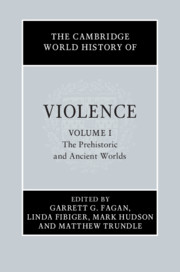Book contents
- The Cambridge World History of Violence
- The Cambridge History of Violence
- The Cambridge World History of Violence
- Copyright page
- Contents
- Figures
- Maps
- Contributors to Volume i
- General Introduction: Violence in World History
- Introduction to Volume I
- Part I The Origins of Conflict
- Part II Prehistoric and Ancient Warfare
- Part III Intimate and Collective Violence
- Part IV Religion, Ritual and Violence
- Part V Violence, Crime and the State
- Part VI Representations and Constructions of Violence
- 29 Kingship, Violence and Non-violence in Indian Thought, c. 500 bce to 500 ce
- 30 Violence and the Bible
- 31 Representations of Violence in Ancient Mesopotamia and Syria
- 32 Representations of War and Violence in Ancient Rome
- 33 Heroism, Military Violence and the State in Ancient India
- Index
- References
29 - Kingship, Violence and Non-violence in Indian Thought, c. 500 bce to 500 ce
from Part VI - Representations and Constructions of Violence
Published online by Cambridge University Press: 13 March 2020
- The Cambridge World History of Violence
- The Cambridge History of Violence
- The Cambridge World History of Violence
- Copyright page
- Contents
- Figures
- Maps
- Contributors to Volume i
- General Introduction: Violence in World History
- Introduction to Volume I
- Part I The Origins of Conflict
- Part II Prehistoric and Ancient Warfare
- Part III Intimate and Collective Violence
- Part IV Religion, Ritual and Violence
- Part V Violence, Crime and the State
- Part VI Representations and Constructions of Violence
- 29 Kingship, Violence and Non-violence in Indian Thought, c. 500 bce to 500 ce
- 30 Violence and the Bible
- 31 Representations of Violence in Ancient Mesopotamia and Syria
- 32 Representations of War and Violence in Ancient Rome
- 33 Heroism, Military Violence and the State in Ancient India
- Index
- References
Summary
This chapter discusses the various ways in which the relationship between kingship, violence and non-violence was conceptualised in ancient India during the period c. 500 BCE to 500 CE, both in general terms as well as in special relation to punishment and war. Examining a variety of textual, epigraphic and visual sources, it identifies a strong and enduring tension in ancient Indian political thought between the ethical principle of non-violence and the pragmatic need for the king to use force while discharging his duties. While non-violence was considered a laudable virtue, there was an acknowledgement, even in Buddhist and Jaina thought, that it was incompatible with political power. At the same time, a distinction was made between necessary force and force that was unnecessary, disproportionate, random or excessive. The former was accepted, the latter condemned. Moral and pragmatic arguments for the measured use of force were accompanied by a constant emphasis on self-control as a desirable royal virtue. By the middle of the first millennium a ‘classical’ model of kingship had emerged, wherein the king’s violence was legitimised and aestheticised. Nevertheless, a window for critiquing the potential and actual violence of the king remained.
- Type
- Chapter
- Information
- The Cambridge World History of Violence , pp. 589 - 606Publisher: Cambridge University PressPrint publication year: 2020

